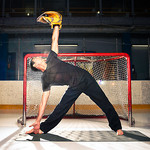This post is part of an occasional series about how yoga influences how I work with clients.
I don’t expect you to do yoga. You don’t even have to attempt the pose I’m going to talk about. Ever. In your whole life.
The point of this series is that yoga has taught me some interesting things about how to approach other things.
In this post I share what seemed like a good example of the principle that it is useful to have a goal in mind but also to accept that you probably won’t reach it.
First, the yoga story

Today we worked on Triangle pose.
After explaining the full expression of the pose, the teacher explained the important elements: wide stance, straight legs, the upper shoulder should be in the same plane as the lower shoulder… We even practiced against a wall to really get what that last one feels like.
None of us looked like the guy in the photo. Not even the teacher.
It turns out that it’s better for that bottom hand to be closer to your knee, than it is to do a (partial) forward fold to get it closer to the floor and throw the alignment of your back out.
What does this mean for you?
It is helpful to be able to visualize what you want to achieve, even if you know you can’t get there right now (or maybe ever).
Knowing what the end result looks like enough to identify the essential elements helps you make decisions about the steps you need to take.
You can judge your progress based on this knowledge of the essential elements.
Doing whatever-it-is partially, but well, can build capacity to do it better in future.
Specifying “good enough”
You may never reach the full expression of your vision. Ever.
I have written before about how perfectionism can prevent you from actually contributing to the scholarly conversation. And yet, if you struggle with perfection, “good enough” seems sloppy. Like you’ve just abandoned any standards.
This principle — knowing the aim and accepting that you may never achieve it — helps you distinguish “good enough” from “I’m fed up”, “I’ll never be able to do this, it’ll have to do”, “oh well, if you can’t get to perfect, what’s the point“, and all their cousins.
“Good enough” has essential elements. It is a step on your way to the bigger vision. It is not a haphazard attempt or abandoning your standards, but rather a well executed position that is clearly recognizable as this pose.








[…] Privacy Policy ← The goal & what you can do […]